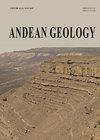Eocene mammals from volcaniclastic deposits of the Somun Cura Plateau: biostratigraphic implications for north Patagonia Paleogene
IF 1.2
4区 地球科学
Q3 GEOLOGY
引用次数: 2
Abstract
The Paleogene terrestrial faunal succession and its associated bearing volcaniclastic deposits has been exhaustively studied in central Patagonia, but there is still no acceptable litho-bio-chronostratigraphic ordering for the extra-Andean North Patagonia. The only references on Paleogene mammals bearing deposits north to Chubut River are imprecise and contradictory. West to Ingeniero Jacobacci (Río Negro Province, Argentina), the paleontologist and archaeologist Rodolfo Casamiquela reported a fossiliferous succession with Casamayoran or Mustersan (Eocene) and Deseadan (Oligocene) mammals from rocks currently mapped as the Las Chacras Formation. This unit includes acid to intermediate tuffs, ignimbrites, paleosols, conglomerates, and basalts originated in a perivolcanic fluvial system, under a seasonal subhumid-humid climate according to predominant pedogenic features. As a result of our fieldworks and fossil collection in the area of Ingeniero Jacobacci, and the revision of the materials collected by Casamiquela in the forties and fifties (with well-known stratigraphic origin), we identified a single mammal association from the lower section of the Las Chacras Formation (here named the Lower Las Chacras fauna) composed by: Plesiofelis schlosseri Roth, 1903 (Sparassodonta), Trigonostylops Ameghino, 1897, Astraponotus Ameghino, 1901 (Astrapotheria), Propyrotherium Ameghino, 1901 (Pyrotheria), Pseudhyrax eutrachytheroides Ameghino, 1901, Eohegetotherium priscum Ameghino, 1901, Puelia sigma (Ameghino, 1901), Periphragnis Roth, 1899 (Notoungulata), Isutaetus depictus Ameghino, 1902 (Cingulata), and a new member of Adianthidae (Litopterna) and probably of Pichipilidae (Paucituberculata). This assemblage is closer to that derived from the Rosado Member of the Sarmiento Formation at Gran Barranca, central Patagonia (type locality of the Mustersan Land Mammal Age) dated in ca. 38 Ma (late middle Eocene). A pyroclastic flow associated to the bearing deposits of Ingeniero Jacobacci was dated (K-Ar) in 39.2±2 Ma, value compatible with the Mustersan age here inferred for the Lower Las Chacras fauna. The alleged occurrence of Deseadan mammals in these levels was based on remains of an isotemnid notoungulate incorrectly identified as a leontinid. The presence of the Tinguirirican (early Oligocene) notoungulate Eohegetotherium priscum, with more apomorphic dental traits than in its Eocene allies, and of an astrapotheriid more derived than Astraponotus suggests that some advanced faunal elements would have been established in North Patagonia earlier than in central Patagonia.索门库拉高原火山碎屑沉积物中的始新世哺乳动物:北巴塔哥尼亚古近系的生物地层学意义
巴塔哥尼亚中部的古近系陆生动物群序列及其相关的含火山碎屑沉积物已被详尽研究,但安第斯山脉以外的北巴塔哥尼亚地区仍然没有可接受的岩石-生物-年代地层顺序。关于楚布特河以北沉积的古近系哺乳动物的唯一参考文献是不精确和矛盾的。在Ingeniero Jacobacci(阿根廷内格罗河省)以西,古生物学家和考古学家Rodolfo Casamiquela报告了Casamayoran或Mustersan(始新世)和Deseadan(渐新世)哺乳动物在目前被绘制为Las Chacras组的岩石中的化石序列。该单元包括酸性至中等凝灰岩、熔结凝灰岩、古土壤、砾岩和玄武岩,它们起源于火山周围的河流系统,根据主要的成土特征,处于季节性亚湿润气候下。由于我们在Ingeniero Jacobacci地区的实地工作和化石收集,以及对Casamiquela在四五十年代收集的材料(具有众所周知的地层起源)的修订,我们从Las Chacras组的下部确定了一个哺乳动物群落(此处命名为下Las Chacras动物群),由:Plesiofelis schlosseri Roth,1903年(Sparassodonta)、Trigonostylops Ameghino,1897年、Astroponotus Ameghino、1901年(Astrophoteria)、Propyrotherium Ameghino(Pyrotheria)、Pseudhyrax eutrachyrides Ameghinos、1901年、Eoegetotherium priscum Ameghino1901、Puelia sigma(Ameghino)、Periphragnis Roth、1899年(Notoungulata)、Isutaetus desictus Ameghino和1902年(Cingulata),和一个新成员的Adianthidae(Litoptena)和可能的Pichipilidae(Paucituberculata)。该组合更接近于巴塔哥尼亚中部Gran Barranca Sarmiento组的Rosado成员(Mustersan陆地哺乳动物时代的典型地区),年代约为38 Ma(始新世中晚期)。与Ingeniero Jacobacci含矿矿床相关的火山碎屑流测年(K-Ar)为39.2±2 Ma,该值与此处为下拉斯-查克拉斯动物群推断的Mustersan年龄一致。所谓的德塞丹哺乳动物在这些水平上的出现是基于一种被错误地鉴定为leotinid的同种无蹄类动物的遗骸。Tinguirirican(渐新世早期)无蹄类始齿兽的存在,其牙齿特征比其始新世的同类更具变形性,以及比Astraponotus更衍生的Astraphoteriid的存在,表明一些先进的动物群元素可能早于巴塔哥尼亚中部在北巴塔哥尼亚建立。
本文章由计算机程序翻译,如有差异,请以英文原文为准。
求助全文
约1分钟内获得全文
求助全文
来源期刊

Andean Geology
地学-地质学
CiteScore
3.90
自引率
0.00%
发文量
17
审稿时长
>12 weeks
期刊介绍:
This journal publishes original and review articles on geology and related sciences, in Spanish or English, in three issues a year (January, May and September). Articles or notes on major topics of broad interest in Earth Sciences dealing with the geology of South and Central America and Antarctica, and particularly of the Andes, are welcomed.
The journal is interested in publishing thematic sets of papers and accepts articles dealing with systematic Paleontology only if their main focus is the chronostratigraphical, paleoecological and/or paleogeographical importance of the taxa described therein.
 求助内容:
求助内容: 应助结果提醒方式:
应助结果提醒方式:


